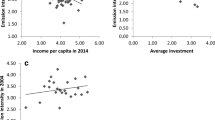Abstract
Under the Kyoto Protocol, industrialized countries committed to emission reductions may fullfil part of their obligations by implementing emission reduction projects in developing countries. In doing so, they make use of the so-called Clean Development Mechanism (CDM). Two important issues surround the implementation of the CDM. First, if the cheapest abatement measures are implemented for CDM projects, developing countries may be left with only more expensive measures when they have to meet their own commitments in the future (the so-called low-hanging fruits (LHF) issue). Second, a choice must be made on the type of baseline against which emission reductions are measured: an absolute baseline or a relative (to output) one (the baseline issue). The purpose of this paper is to study the interactions between these two issues from the point of view of the developing country. Two major results are obtained. First, when possible future commitments for developing countries and irreversibility of abatement measures are taken into account, we show that the industry where CDM projects are implemented enjoys larger profits under an absolute baseline than under a relative one. Second, concerning the LHF problem, the financial compensation required by the developing country for implementing ‘too many’ CDM projects is larger under the relative baseline.
Similar content being viewed by others
References
Akita J (2003) A simple model of CDM low-hanging fruit. In: Sawa T (ed) International frameworks and technological strategies to prevent climate change. Springer, Tokyo
Akita J, Imai H, Niizawa H (2005) Ex-post CDM baselines, self-leakage and counterproductive CDM. Institute of Economic Research, Kyoto Univeristy, Working Paper n° 607, Mimeo
Bréchet T, Germain M, van Steenberghe V (2004) The clean development mechanism under the Kyoto Protocol and the ‘low-hanging fruits’ issue. CORE Discussion Paper, 2004/81, CORE, Université catholique de Louvain
Fischer C (2001) Rebating environmental policy revenues: output-based allocations and tradable performance standards. Resources for the Future, Discussion Paper 01–22
Fischer C (2005) Project-based mechanisms for emissions reductions: balancing trade-offs with baselines. Energy Policy 33(14):1807–1823
Imai H, Akita J, Niizawa H (2005) On alternative CDM baseline schemes and their appropriateness: ex-ante, ex-post, and ex-post proxy baselines. Interfaces for Advanced Economic Analysis, Kyoto University, Discussion Paper n° 083, Mimeo
Janssen J (2001) Risk management of investments in joint implementation and clean development mechanism projects. Ph.D. Dissertation, Université de St. Gallen, Suisse
Laurikka H (2002) Absolute or relative baselines for JI/CDM projects in the energy sector? Clim Policy 2:19–33
Millock K (2002) Technology transfers in the clean development mechanism: an incentives issue. Environ Dev Econ 7:449–466
Narain U, van’t Veld K (2005) Virtual options to turn ‘CO2lonialism’ into ‘Clean Development’. Resources for the Future, Working Paper 05–17
Rose A, Bulte E, Folmer H (1999) Long-run implications for developing countries of joint implementation of greenhouse gas mitigation. Environ Resour Econ 14:19–31
UNFCCC, United Nations Framework Convention on Climate Change (2001) The Marrakesh accords and the Marrakesh declaration, Report of the Conference of the Parties on its seventh session held in Marrakesh for 29 October to 10 November 2001, available at www.unfccc.int
Winkler H, Thorne S (2002) Baselines for suppressed demand: CDM projects contribution to poverty alleviation. S Afr J Econ Manage Sci 5(2):413–429
Author information
Authors and Affiliations
Corresponding author
Rights and permissions
About this article
Cite this article
Germain, M., Magnus, A. & van Steenberghe, V. How to design and use the clean development mechanism under the Kyoto Protocol? A developing country perspective. Environ Resource Econ 38, 13–30 (2007). https://doi.org/10.1007/s10640-006-9066-3
Received:
Accepted:
Published:
Issue Date:
DOI: https://doi.org/10.1007/s10640-006-9066-3




